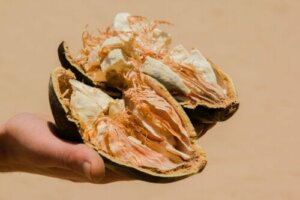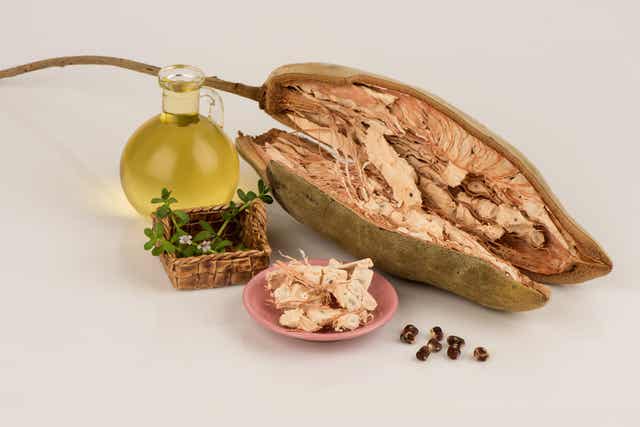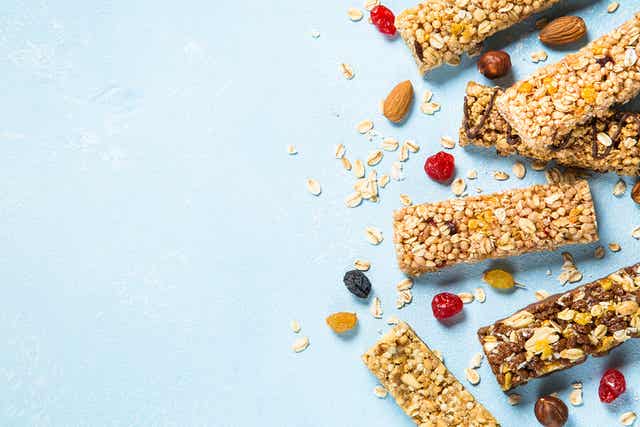Baobab Fruit: Characteristics, Benefits, and Contraindications


Written and verified by the nutritionist Maria Patricia Pinero Corredor
From toothache and fever relief to pesticide use, the baobab is a tree that has more than 300 traditional uses in different parts of Africa. Perhaps the most relevant of these is the fact that it’s also a great food to eat. Of its 8 species, the best known is Andasonia digitata, which many consider to be a superfood.
This gigantic tree is part of old legends that claim that God hung this tree upside down, with the branches on the ground and the roots on top. The name comes from Arabic and means “father of many seeds.”
The baobab fruit is inside a hard oval pod. Inside, there is pulp with a bittersweet flavor that contains the seeds. A group of experts considers this fruit to be remarkable in nutrient richness.
It’s sold as a powdered food to ship across borders. However, since it’s so new in some countries, researchers are still studying its risks. To learn more about this fruit, its benefits, and contraindications, keep reading.
Nutritional properties of the baobab fruit
A study calls this a “superfruit” since its nutritional profile highlights lots of nutrients. For example. it has lots of vitamins, minerals, and fatty acids.
Baobab fruit is very rich in vitamin C and fiber. According to a group of pharmacists, the pulp contains between 7 to 10 times more vitamin C than oranges, with values ranging between 280 to 300 milligrams per 100 grams of fruit.
Just consuming 40 grams of baobab pulp can cover 100% of the recommended daily intake in pregnant women. Also, it highlights its amount of vitamin B1 and B6. Regarding minerals, calcium values vary between 250 and 350 milligrams per 100 grams of pulp.
Potassium is also abundant in this fruit, containing between 1240 and 1578 milligrams, which is 4 times higher than bananas. Additionally, there is 5 times more magnesium in baobab fruit than in avocados.
Other studies highlight that 36% of the nutrients are carbohydrates, such as glucose, fructose, and sucrose, which give the seed a sweet flavor. Another part is soluble fiber, represented by pectin. As if that weren’t enough, specialists have studied its high concentration of essential fatty acids, such as omega 6 and omega 9.
Despite its nutritional properties, most experts agree that the bioavailability of nutrients in the baobab fruit and its products needs to be studied further, since there isn’t much information on this.

Keep reading to learn more: Complex B Vitamins: Characteristics, Benefits, and Functions
Possible benefits of the baobab fruit
Since this fruit has lots of nutrients and other active phytochemicals, there are several different health benefits. Some of these are:
- Rejuvenates the skin: Several researchers recognize that the oil in the baobab fruit helps skin cell renewal, due to its vitamin A. Also, vitamin E participates as an antioxidant.
- Regulates blood pressure: The high potassium content has a vasodilator effect. In this way, it can reduce the risk of suffering from pulmonary embolisms, as well as heart disease.
- Strengthens the immune system: The richness in vitamin C gives it the ability to increase the levels of white blood cells.
- May support bone health: The high content of calcium and magnesium supports bone health. In fact, it’s part of preventative diets for osteoporosis.
- Analgesic and anti-inflammatory: A possible analgesic and antipyretic effect of warm baobab extract have been proven. One study even demonstrated the pulp’s anti-inflammatory activity in laboratory animals.
- Antioxidant: The fruit’s high phenolic content stands out for its antioxidant capacity. It has so much that some authors have even suggested it as a dietary supplement.
- Protects the liver: The results of a study suggested that consuming this fruit could help protect the liver in laboratory animals. This is because of its triterpenoid compounds and sterols.
- Gastrointestinal health: Some African communities use this fruit to relieve constipation, gastroenteritis, and diarrhea. Its soluble fiber can also help beneficial bacteria grow in the intestine.
Check this out: Eat Five Fruits and Vegetables a Day and Live Longer
How to eat it
The baobab fruit is considered a staple food in many regions of central Africa. There, they dissolve the pulp in water or milk to use it as a drink and sauce. Additionally, they use it as a leavening agent in local brewing and is a good substitute for cream of tartar in baking.
Also, you can use the pulp to make ice cream, juices, and jams. You should never cook it, but you can add it at the end when the preparation is already at room temperature.
As for the seeds, you can eat them fresh or dried, or you can grind them into flour to add to soups and stews as a thickener. Also, you can roast them before grinding them to a paste. Then, they will be fermented and dried.
It’s sold in the market in powder form, and you can use it as a sports supplement, as well as in nutritional formulations. You can add it to smoothies, cereals, energy bars, yogurts, dairy, and juices.

Is there any risk in consuming it?
Even though baobab fruit has been certified as safe in the United States and the European Commission authorized its import as a new food, the tests on its health properties have only been done on animals.
For this reason, until scientists do risk studies on humans, you should be very careful when consuming it, and make sure to respect the recommended servings. There are many nutritional, medicinal, and health benefits that it provides. However, you need to be careful about excessive consumption.
All cited sources were thoroughly reviewed by our team to ensure their quality, reliability, currency, and validity. The bibliography of this article was considered reliable and of academic or scientific accuracy.
- Buchmann C, Prehsler S, Hartl A, Vogl CR. The importance of baobab (Adansonia digitata L.) in rural West African subsistence–suggestion of a cautionary approach to international market export of baobab fruits. Ecol Food Nutr. 2010 May-Jun;49(3):145-72.
- Vertuani, E. Braccioli, V. Buzzoni, S. Manfredini. Anti-oxidant capacity of Adansonia digitata fruit pulp and leaves. Acta Phytotherapeutica, 2 (2002), pp. 86-91
- Gruenwald. Novel botanical ingredients for beverages. Clinics in Dermatology, 27 (2009), pp. 210-216.
- Osman MA. Chemical and nutrient analysis of baobab (Adansonia digitata) fruit and seed protein solubility. Plant Foods Hum Nutr. 2004 Winter;59(1):29-33.
- Gebauer, K. El-Siddig, G. Ebert. Baobab (Adansonia digitata L.): a review on a multipurpose tree with promising future in Sudan. Gartenbauwissenschaft, 67 (2002), pp. 155-160.
- Lockett CT, Calvert CC, Grivetti LE. Energy and micronutrient composition of dietary and medicinal wild plants consumed during drought. Study of rural Fulani, northeastern Nigeria. Int J Food Sci Nutr. 2000 May;51(3):195-208.
- De Caluwé, K. Halamová, P. Van Damme. Baobab (Adansonia digitata L.): a review of traditional uses, phytochemistry and pharmacology.H. Rodolfo, J.E. Simon, C.-T. Ho (Eds.), African natural plant products: new discoveries and challenges in chemistry and quality, Oxford University Press, USA (2009), pp. 51-84.
- Nkafamiya, S.A. Osemeahon, D. Dahiru, H.A. Umaru. Studies on the chemical composition and physicochemical properties of the seeds of baobab (Adasonia digitata). African Journal of Biotechnology, 6 (2007), pp. 756-759
- Ramadan, F.M. Harraz, S.A. El-Mougy. Anti-inflammatory, analgesic and antipyretic effects of the fruit pulp of Adansonia digitata. Fitoterapia, LXV (1994), pp. 418-422
- Vimalanathan , JB Hudson .Múltiples actividades inflamatorias y antivirales en hojas, frutos y semillas de Adansonia digitata (Baobab). Revista de investigación de plantas medicinales , 3 ( 2009 ) , págs. 576 – 582.
- Nhukarume, Z. Chikwambi, M. Muchuweti, B. Chipurura. Phenolic content and antioxidant capacities of Parinari curatelifolia, Strychnos spinosa and Adansonia digitata. Journal of Food Biochemistry, 34 (2008), pp. 207-221
- Al-Qarawi, M.A. Al-Damegh, S.A. El-Mougy. Hepatoprotective influence of Adansonia digitata pulp. Journal of Herbs Spices and Medicinal Plants, 10 (2003), pp. 1-6
This text is provided for informational purposes only and does not replace consultation with a professional. If in doubt, consult your specialist.








